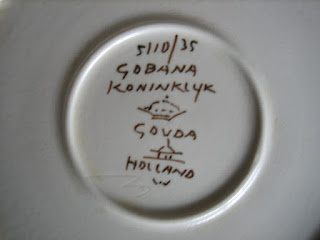 This weekend I have been invited by my colleague to see a monthly antic goods market in Mechelen, 25 km from Brussels. Actually it is not really an antic exhibition; it is a well organized indoor flea market (Brocante in French). My colleague persuades me that in this market we can find some antic goods. We can bargain and if we are lucky enough, we can get it in low price.
This weekend I have been invited by my colleague to see a monthly antic goods market in Mechelen, 25 km from Brussels. Actually it is not really an antic exhibition; it is a well organized indoor flea market (Brocante in French). My colleague persuades me that in this market we can find some antic goods. We can bargain and if we are lucky enough, we can get it in low price.One of my colleague’s favorite, among so many things sold by traders in that market, is Gouda pottery. It is a style of Dutch pottery named after the city of Gouda, a city and municipality in the western Netherlands, in the province of South Holland. Gouda pottery is diverse and visually distinctive in appearance, typically illustrated with colourful and highly decorated Art Nouveau or Art Deco designs. Gouda pottery gained worldwide prominence in the late 19th and early 20th century and remains highly desirable to collectors today.
At that time, there were many factories spread over the Netherlands producing the "Gouda style" of pottery. Factories such as PZH (Plateelbakkerij Zuid-Holland) Regina, Schoonhoven, Ivora, Goedewaagen and Zenith, were well known. They all had their own styles, patterns, decorators and designers. After the World War II, some factories stop their productions and some still continue with their new products. But according to the collectors, the new Gouda potteries are not so good; sadly quality and design began to suffer.
In this regard I could understand why the old Gouda pottery, in its original design, hunted by many collectors around the world for collection or resells. In Indonesia itself, collectors are looking Gouda pottery not only because it’s fabulous beauty but also by it’s high historical value. During the Dutch colonialism era, Dutch government officials and traders brought this pottery to Indonesia, as a gift or present to the local authorities.
After almost one hour hunting “antic goods”, finally I found a trader who sells Gouda Pottery. The trader, an old lady who can speak Germany, Netherlands, French and English, showed me a Gouda pottery plate decorated with flowers and leaves. This plate made in Gouda by Gobana Koninklyk Gouda Holland on model number 5110/35. There is a symbol in this plate to show the date mark (see photo below). The trader mentioned that it is a typical Gouda pottery made in 1940s.

Other Gouda pottery plate is a two handled hand painted Gouda dish by Bianca. The dish is in good condition with only tiny defect at the back side. The model number is 3231p with the same decoration and symbol as the Gouda pottery plate above (see two photos below).
Looking to this two plate, we can notice that they have same decoration, made by two different factories, but it made in the same periode, most probably in the 1940s as mentioned by the trader.
UPDATE:
For more Gouda Pottery's collection please visit http://gallery2000.blogspot.com


2 comments:
ihiks... mas udah jadi kolektor barang antik nih .... udah berapa lukisan dikumpulin nih ...sayang nih di beo kagak ada flea market .. :(
atau guenya aja yg kagak tahu ya .. :D
Dung, utk tahu tempat2 flea market harus rajin2 cari informasi kanan kiri. Biasanya informasi datang dari mulut ke mulut :)
Post a Comment